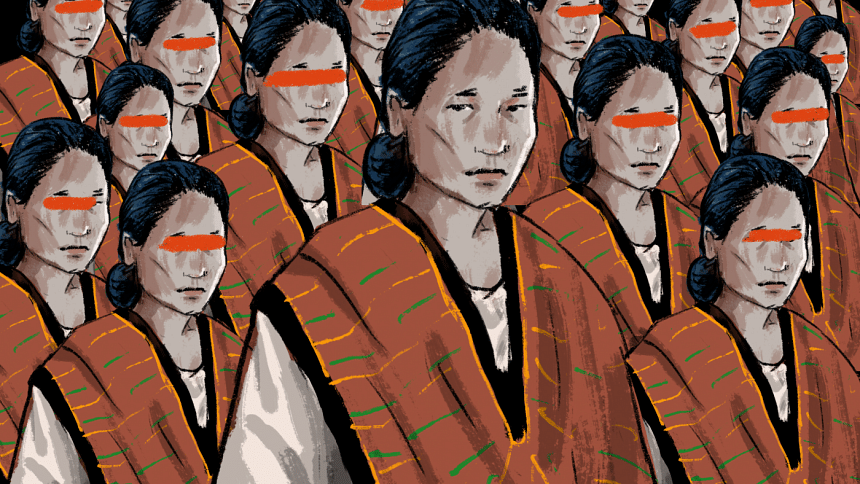
In July 2024, while Bangladesh's former government violently repressed student protests and imposed a communication blackout to silence voices, the name "Kalpana Chakma" echoed similar experiences in the hills. Kalpana stood again as a mirror, reflecting the experiences of subjugation and, ultimately, resistance to tyranny. As a "new" Bangladesh emerges, knowing who Kalpana Chakma is becomes crucial in understanding our shared history—of Bangalees and Adibashis (the Indigenous).
To know her, you must know what she stands for. The United Nations recognises Indigenous peoples as inheritors and practitioners of unique cultures with social, cultural, economic and political characteristics distinct from dominant societies' where they reside in. Being Indigenous, thus, implies self-determination—the right to freely determine political status and pursue economic, social and cultural development.

In 1860, the British annexed Chittagong Hill Tracts (CHT) region. Special regulations were passed, preserving the region's special character and recording the presence of Indigenous groups. After independence, the 1972 Bangladesh constitution recognised only the Bangalee culture and language, and designated all citizens of Bangladesh as Bangalee.
According to the study, "Ethnic Problems in Bangladesh: A Study of Chittagong Hill Tracts" (2014), CHT representatives, under the leadership of Manabendra Narayan Larma, who served as the Adibashi representative in parliament, sought the recognition of Indigenous status. President Sheikh Mujibur Rahman rejected their demands, saying "Forget your ethnic identity, be Bengalis." Their demands were met with establishment of three cantonments in Ruma, Alikadam and Dighinala in 1973, as reported by International Work Group for Indigenous Affairs.
From 1975 to 1981, during Bangladesh's military rule, the government began state-sponsored migration programmes of Bangalee settlers into the hill region in phases, leading to continuing ethnic tension, as detailed in "Between Ashes and Hope: Chittagong Hill Tracts in the Blind Spot of Bangladesh Nationalism" (2010). Claimed as an outcome of the measures of counter-insurgency and protection of national borders, today CHT remains the only fully militarised area in Bangladesh. Against this backdrop, Kalpana Chakma was a frontline activist in the struggle for self-determination of Indigenous peoples.
Even from a young age, she was very politically conscious. The first-year graduate student of Baghaichari College served as the organising secretary of the Hill Women's Federation, a wing organisation of Parbatya Chattagram Jana Samhati Samiti. In the words of a fellow comrade, "If there was a conference in Khagrachori, she would come all the way from Baghaichari.
Whereas many were shy, Kalpana spoke fluently on stage. She was only 23 years old, yet she stood out for her organisational discipline and took the responsibility of her group members at meetings." International CHT Commission adviser Meghna Guhathakurta writes, "Kalpana did not interpret democracy as only free and fair elections, rather participation in the political process, especially as a Chakma and a woman.
She did not hold herself back from criticising her own student movement as male-dominated and neglectful of women's emancipation in agendas for class struggle and political change." In Dina Mahnaz Siddiqui's chapter titled, "Against Forgetting: Gendered Justice in 'Post-conflict' Bangladesh" in the book Women and Politics of Peace: South Asia Narratives on Militarization, Power, and Justice, it is mentioned that the general parliamentary elections of Bangladesh were set to be held on June 12, 1996. Kalpana participated in electioneering in favour of independent candidate Bijay Ketan Chakma.
A few days prior to the election, she got into a public dispute with the then Lieutenant Ferdous Kaisar Khan over the issue of burning down of houses in her village. She was also campaigning for an enquiry over the rape and murder of Shapna Rekha Chakma from her village. Multiple news reports, quoting her brothers Kalindi and Khudiram, state that in the early hours of the election day, Kalpana, along with her brothers, were abducted at gunpoint from their home in Lallyaghona village.
The brothers managed to escape and raised allegations against Lieutenant Ferdous of Kojoichhari army camp and Village Defence Party members Nurul Haque and Saleh Ahmed from Ugolchari. The police took almost 14 years to complete the probe. However, the 2010 report did not say anything conclusive about the suspects.
Her family rejected subsequent similar reports. By 2016, 39 police officers had investigated her abduction case. After several hearings, this year the court accepted the final report, clearing all the suspects.
"We loved her so much since she was a kid. We worked in other people's houses and saved money for her studies. She was the only one in our family who studied.
But what a fate! We lost her. Whenever an organisation comes to us, we tell the same story. It's been years and we are yet to receive justice," Kalindi's words reflect the institutional impunity within the CHT.
Even after 28 years of miscarriage of justice, her family has to hear strange rumours—she was involved in a "love affair" with the abductor or that she is in India. Kalpana's disappearance is not an isolated event. The meanings attached to her absent body reveal systematic issues operating against justice delivery for unseen Indigenous sisters.
Yet Kalpana remains a sign of resistance and solidarity in the face of oppression. Kalpana will never die. Her graffiti can be wiped out but she lives through us.
Kalpana is you. Kalpana is me. She reminds us of our fight against oppression and the enduring quest for justice.
Like her name, Kalpana allows us to imagine what it means to stand up for our values against overwhelming odds. Myat Moe Khaing is a marketing strategist at a multinational company, who takes an interest in Indigenous and gender politics. Views expressed in this article are the author's own.
Follow The Daily Star Opinion on Facebook for the latest opinions, commentaries and analyses by experts and professionals. To contribute your article or letter to The Daily Star Opinion, see our guidelines for submission ..














